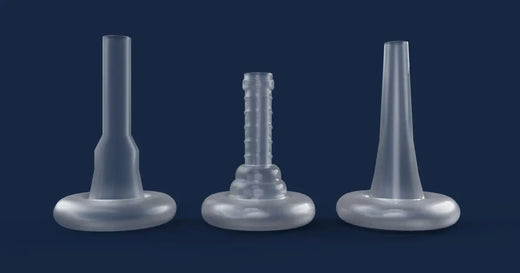What is a urinary sheath?
Urinary sheaths are similar in appearance to a condom. They’re applied to the penis (either by the individual, carer, partner or family member) and stay in place thanks to a skin-friendly adhesive on the inside of the sheath, there are also non adhesive sheaths available to those that need it. There’s a soft, silicone (Or latex) tube on the end where a leg bag can be attached. Because urine drains directly into the leg bag, the surrounding skin remains dry. Odour is also less of a concern with urine contained within the leg bag.
Urinary sheaths can also create a better experience in terms of patient dignity as they’re much more discreet and for many, can feel more hygienic. Urinary sheaths can improve the quality of life compared to individuals who use incontinence pads. It is important individuals are offered a choice so they’re able to select whichever product they think they’ll feel most comfortable using.
What is a condom catheter or external catheter?
You may have heard the terms condom catheter, external catheter or even a uridome and be confused about the difference between them and a sheath– but there is none. Urinary sheaths, condom catheters, external catheters and uridomes are all the exact same thing.
How to apply a urinary sheath
To help you get the best from your sheath we suggest you follow the below guidelines – remember you should always check the user instructions for the one you’re using.
- First off, if required, trim any excess hair from the penis with scissors or use a hair guide. (Some sheaths come with a handy pubic hair protector to make the fitting process even easier)
- You should wash your penis with non-moisturising soap and water then pat the area dry.
- Check for signs of soreness on the skin. If there are no problems with your skin, you can go ahead and apply your sheath. However, if you spot some broken or irritated skin it’s better to not apply a sheath. Speak to your healthcare professional; they will help you find a different option of managing your incontinence while your skin is healing.
- Next, wash your hands and dry them properly. When you’re ready, apply the sheath following the manufacturer’s instructions (Your foreskin should not be retracted when fitting your sheath)
- Make sure that you leave a few cms of space between the end of the penis and the sheath.
- Once the sheath has been rolled down, make sure you hold it in place for a minute to ensure the adhesive has bonded to get a good seal and prevent leakage.
How to attach a leg bag to your urinary sheath
As a next step, you will likely want to attach a leg bag. Before connecting the bag to your urinary sheath, secure it to your leg and make sure that it feels comfortable and that you can move freely. If you’re using leg bag straps, slide them through the slots in your leg bag and make sure they run behind the bag. Then adjust the straps so they hold your leg bag in place but are still comfortable. If your straps have a grippy surface. Alternatively, you can also use a leg bag sleeve or leg bag holder to support your leg bag and keep it in place.
It’s time to fit the leg bag connector to the sheath spout and check that the connection is secure. Ensure that there are no kinks in the tube and that your urine bag is positioned below the level of your bladder, you should regularly check that your sheath and drainage tubing are free from obstruction and urine is draining freely. Normally leg bags can be used for 5-7 days – but it’s important you follow the user instructions for the one you’re using.

How to remove a urinary sheath
Generally, a urinary sheath can be worn for 24 hours. However, this can vary from manufacturer to manufacturer so it’s important to check the user instructions for the one you’re using.
We suggest the following advice for the removal of the sheath:
- Before removing your sheath, wash and dry your hands properly.
- Loosen the base of the sheath from the penis all the way around. If it seems stuck, try using soapy water or an adhesive remover to remove your urinary sheath.
- This will help you to release the base all the way around and you will be able to roll the sheath off your penis.
- Always inspect the penile sheath after removal and before fitting your next one.
- You should dispose of the used sheath in your bin at home.
Who can and can't use a urinary sheath?
It’s very important that you speak to your healthcare professional before using a urinary sheath to make sure it’s A) right for you, and B) that you are wearing the correct size.
A urinary sheath can be used whether you’re circumcised or not and suffer from moderate to severe incontinence. It might also be a great option if you struggle to get to the toilet in time due to mobility issues. A sheath, unfortunately, won’t be right for you if you can’t empty your bladder by yourself and it also won’t help you to pass urine.
To use a urinary sheath, your penis will have to have a certain diameter and length to use a sheath. Generally speaking, your length will need to be around 2.5 centimetres or 1 inch long (there are different options available if shorter than this length). You or your carer will also need to be willing to learn how to use a sheath and you will need to have enough dexterity to apply and remove the sheath if you’re using it yourself.
Please note that the above information is for guidance only, we recommend that you speak to your healthcare professional to see if you can or can’t use a urinary sheath.
Why is correct sizing so important?
Wearing a sheath that’s too tight can cause discomfort and sore skin; wearing a sheath that’s sitting too loose can lead to leakage or, worst case, it can even fall off. Sheaths usually come with a specially designed measuring guide. If possible, use those to measure as sizes can vary with different brands. They also come in two lengths – standard and shorter – to give you the best possible fit. We know, this all sounds super complicated! But don’t worry, your healthcare professional will be able to assist with every step of the way.
Can I go swimming with a urinary sheath?
We wouldn’t advise anyone to swim whilst wearing a sheath as there is a high risk of the sheath being pulled, loosening in the water, and coming off. You should always consult your healthcare professional to discuss the most suitable products if you would like to go swimming.
|
Useful contacts Vyne Nurses Our nursing team are here to help, click here to book an appointment today. Bladder and Bowel Community General enquiries: 01926 357220 |
References
1. https://www.kentcht.nhs.uk/wp-content/uploads/2016/06/Care-of-your-sheath-00296-v5.pdf





